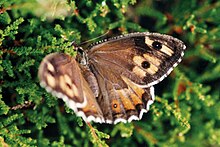Grayling (butterfly)
| Grayling | |
|---|---|
 |
|
| Female | |
 |
|
| Underside, Greenham Common, Berkshire | |
| Scientific classification | |
| Kingdom: | Animalia |
| Phylum: | Arthropoda |
| Class: | Insecta |
| Order: | Lepidoptera |
| Family: | Nymphalidae |
| Genus: | Hipparchia |
| Species: | H. semele |
| Binomial name | |
|
Hipparchia semele (Linnaeus, 1758) |
|
The grayling, or rock grayling, (Hipparchia semele) is a species in the brush-footed butterfly family Nymphalidae.
Male
Male underside
Female
Female underside
It is found in Europe below 63°N eastwards to extreme western Russia. It is absent from Albania, Macedonia and South Greece.In the north of its range it is coastal for some reason and in the South of its range it is replaced by other Hipparchia species. They are only slightly different and together with semele form a cryptic species complex - Hipparchia aristaeus, Hipparchia christenseni, Hipparchia cretica, Hipparchia mersina, Hipparchia pellucida, Hipparchia volgensis.
Coast, dunes, salt marsh, undercliffs, clifftops, dry heathland, calcareous grassland, old quarries, earthworks, derelict old spoil heaps, open woodland on stony ground, dry and well-drained soil, with sparse vegetation and plenty of bare ground in open, sunny, positions.
Note that information on this species applies to Great Britain and some details may not be consistent with the species in other parts of its range.
There is one generation. The eggs are laid from July to September singly on the food plant.The eggs are white at first, but turn pale yellow. The egg stage lasts between 2 and 3 weeks. The first instar and second instar larva feed in mid to late summer and then hibernate (while still small), in the 3rd instar, at the base of the tussock. Feeding resumes in the spring and the last instar larvae are nocturnal,hiding in the base of grass tussocks during the day. There are 4 moults in total.The pupa is unattached, in an earth cell. The pupal stage lasts around 4 weeks. The larval instars are August to June,the pupa is formed June to August and the adult flies June to August.
egg
...
Wikipedia
